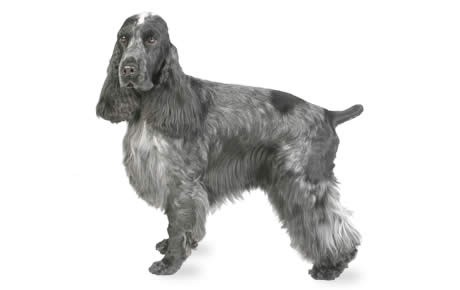English Cocker Spaniel Breed Guide

Breed Group:
Sporting Dogs
Get 30% off
Join our Newsletter
Sign Up Today
English Cocker Spaniel Background & History
The Spaniel is a canine that has a lineage which dates far back into the folds of history (as early as the 16th century). The actual name Spaniel derives from Old French and means ‘Spanish Dog.’ At the time, there were various different types of the breed, but they were most notably used for hunting, particularly a bird called the Woodcock.
Normally, these dogs were ‘pick of the litter.’ This means that Spaniels would breed, and the dogs would be assigned to certain lifestyles based off their characteristics. This is to say that there were no breeds set in stone, and that variations were many. But in the beginning of the 19th century, breeders in England began to streamline the breed and enforce taxonomy.
One such Spaniel was the Cocker, and they were said to be smaller, a bit lither, and with a much denser coat than the other Spaniels. As generations of breeding progressed, there became an apparent difference between the English and American Cocker Spaniel. Respectively, each breed had (and still has) more popularity in its own country.
By the middle of the 20th century, both the breeds had become streamlined, and the AKC recognized the English Cocker Spaniel in 1946. While their popularity is still not apparent here in the states, it’s only helped preserve the purity of the breed.
English Cocker Spaniel Temperament & Personality
The English Cocker Spaniel personality is the mixture of the quiet, attentive hunting dog, and the affable home-lover that just wants to be with its family. These dogs certainly are barkers, and while they can be reserved and even wary of strangers, that sentiment usually wanes the moment they’re given affection. They’re decent watchdogs for this reason, but not necessarily praised as such.
They’re loyal to no end, adore being part of family activities, and can be pleasantly playful. In many regards—despite having the hunt in them—the English Cocker Spaniel temperament and personality mirror that of the Labrador (which is a safe point of reference to use). Perhaps one substantial difference is just how intelligent the English Cocker Spaniel is (as seen in both how easily they learn, and how intuitive they are to their owner’s moods).
These dogs can grow restless, however, and do need stimulation. If left alone for long periods of time, that affable, calm nature can become introverted, anti-social, and anxious. But generally speaking (and it’s easier to generalize a breed that doesn’t have an abundance of puppy mills spitting out pups), they’re fantastic companions that are docile, loving, and well-tempered.
Training an English Cocker Spaniel
The English Cocker Spaniel characterisitics are docile, trainable, and even enthusiastic when it comes to learning. There truly aren’t many accounts of these dogs being difficult to housebreak (they’re quite adaptable for their size) or teach obedience. But because they’re a dog with the ‘hunt’ in them, they do require stimulation, and that’s why obedience classes benefits this breed. By taking them to obedience classes, they’ll learn quickly and take the lessons home.
At home—you as the owner—need to be aware of a Cocker Spaniel’s sensitivity. Some dogs benefit from an owner that asserts himself as the master and plays the role of ‘pack leader.’ This isn’t one of them. While the Cocker Spaniel should respect your authority, and know you’re captain of the ship, only a positive reward system should be used to train them. Reinforce them with praise (this can be in the form of praise, treats, toys, playtime, etc.). If you hold too firm of a hand (or if you angrily scold them), they can become reclusive and insecure, in turn making them less social and anxious.
Early-socialization is a big one for this breed, too. The English Cocker Spaniel traits make them natural lovers and often accepting of other canines and people, but to cultivate that you’ll need to expose them to the world. Take them to dog parks, around your friends, and out on the street in their early years so to accustom them to their environments, as the more comfortable they are in adulthood, the better-tempered they’ll be.
It’s important to note that the training process—across the board—is a primary source of stimulation for your English Cocker Spaniel. Stimulation is what they thrive off of.
Exercise Requirements for the English Cocker Spaniel
While these dogs are and were bird-hunters, their need for exercise isn’t as pronounced as you might expect. It’s more their need for stimulation (which comes with training—see before). In their early years, especially once they start growing into their bodies, they’ll want to run around a lot. Exercise them for around 20-30 minutes daily, and then allot a couple sessions in the backyard or outside for them to walk around.
These dogs love to play. They have a rather strong prey-drive, meaning they’re easily stimulated by moving/noisy things, so a squishy ball is their forte. They’ll play fetch until the sun rises and chase you around if you let them. Combining play and training is a perfect way to exercise your English Cocker Spaniel’s mind and body, keeping them healthy and stimulated at once.
Keep in mind, some English Cocker Spaniels grow a bit too quickly into their bodies, and can often injure their joints if they’re exercising too rigorously on a newly-developed frame. Be aware of this.
English Cocker Spaniel Lifespan & Longevity
The English Cocker Spaniel typically lives anywhere from 12-15 years.
Are English Cocker Spaniels a popular breed?
The English Cocker Spaniel is 54th on the AKC’s most popular list of 155 dog breeds. While not as popular as the American Cocker Spaniel (however, the rest of the world favors the English Cocker Spaniel), they’re still in the top half of the list. Although this dog is incredibly well-rounded, their lack of popularity only preserves the integrity of the breed (because the breed remains closer to its origins, since there isn’t a high demand, which lessens the chance of irresponsible breeding), which in turn has given them more of a presence here in the US.
Feeding Requirements for an English Cocker Spaniel
It’s recommended that your Cocker Spaniel eats 1.5-3 cups of dry food per day, broken into two equal meals. These dogs aren’t necessarily glutinous about their food, nor are they prone to obesity, but it’s important to ensure that you’re giving them the highest-quality food, and leveraging that against their activity level.
Age, metabolism, and weight are also important factors to consider when creating a balanced diet for your Cocker Spaniel. Similar to us as a species, no two dogs are the same and their meal requirements rely on variables exclusive to them. Be sure to monitor their diet carefully, and consider all these factors when feeding your English Cocker Spaniel.
English Cocker Spaniel Grooming
Grooming an English Cocker Spaniel is not a fun task (depends on who you ask, perhaps). Point is: there’s a lot of work involved. Just by looking at one of these fluff balls it’s pretty easy to deduce that they shed. Their long silky smooth (sometimes wavy or even slightly curly) coats cover most of their body, with feathering on the inside of their legs, stomachs, chests, ears, and sometimes at the end of their neck.
They come in assortment of different colors (often named differently), ranging from black to light shades of autumn red. Their coats require professional grooming. By that we don’t mean it’s not in your capabilities to groom them, but that there will certainly be a learning curve (this is because it requires stripping).
If you want to show your English Cocker Spaniel, then know you’re going to be sinking some money into the grooming process. Basic brushing will need to occur daily, as this will drastically mitigate shedding. In terms of hygiene, trim their nails once a month. Then brush their teeth 2-3 times a week to avoid tartar or bacteria buildups.
Examine their nose, eyes, mouths, ears, and bodies for anything suspicious. Take a particularly long time in the ears, as those droopy things can often be the stomping grounds for bacteria or parasites. Check for sores, redness, inflammation, infection (often announcing itself by odor), rash, and anything that seems abnormal. Use these sessions and incorporate them into obedience training early on so to accustom your dog to the process, as this will make it easier for you to groom/examine them ongoing.
Are English Cocker Spaniels good with children?
The English Cocker Spaniel tolerates children and (generally) does well with them. They aren’t an aggressive breed, and if both the children and English Cocker are introduced early on and taught to interact appropriately, it should be smooth sailing. However, the English Cocker does have a rather intense prey-drive, and they can be a bit barky. They score well with children, but need to be supervised initially, as in their youth they can play a bit too hard.
With that being said, they often grow to become loyal, loving, astounding companions for the youngsters, and have enough energy in their puppy years to keep up with them.
Common English Cocker Spaniel Health Problems
Due to a lack in demand, the roots of the English Cocker Spaniel are strong, and they’re often bred responsibly. This is reflected by their average lifespan, which extends well into a decade. However, it’s always important to ensure that your breeder can provide health clearances for both of the parents. These clearances need to be administered by certified establishments, and provided when requested. While it’s rare that your dog will experience these conditions, some English Cocker Spaniel health issues that can afflict him are as follows:
Progressive Retinal Atrophy (PRA): English Cocker Spaniel eye problems are common, especially progressive retinal atrophy. This degenerative disease occurs when the photoreceptors at the back of the eye begin to fail. What begins first as night-blindness eventually progresses into trouble seeing during day time. PRA will almost always cause complete blindness. The one silver lining is that this condition can be diagnosed early on, allotting a fair amount of time for both the owner and the dog to prepare for blindness.
Hip Dysplasia: a common condition found in bigger hunting dogs, this occurs when there’s displacement between the hip bone and the thigh joint. It can cause severe pain, lameness in the leg(s), an abnormal gait, and difficulty walking. While there are multiple different treatments for hip dysplasia, often the canine (depending on the severity) can correct their gait and live a perfectly normal life. For particularly bad cases, corrective surgery can be done.
Renal Failure: this condition occurs when the kidney(s) fails. It’s thought to be hereditary, and there is no link to a certain specification of English Cocker Spaniel that inherits it. If one kidney fails, it is exponentially better than both, as often the dog will have to be put down when both become obsolete.
Other Resources
National breed website: English Cocker Spaniel Club of America
Rescues: Camp Cocker Rescue
Health Issues Associated with this Breed:
- Anxiety
- Bronchitis
- Congenital Sensorineural Deafness
- Dilated Cardiomyopathy
- Eye Infections
- Glaucoma
- Hip Dysplasia
- Inflammation
- Intervertebral Disc Disease (IVDD)
- Pain
- Renal Failure
- Separation Anxiety





